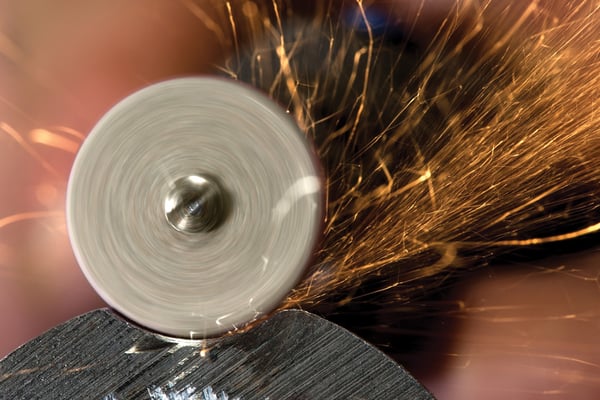Every abrasive product has unique qualities that make it a good or bad fit for certain applications. Determining which abrasive grain and bond combinations are best suited to your metal finishing needs is key to optimizing workflow. Selecting the wrong consumable can have the shop floor clocking extended hours to produce average quality parts.

Choose the Best Grain for Your Operation
With the introduction of dozens of new fillers and proprietary bonding agents, shop managers tasked with selecting abrasive wheels can be left overwhelmed by the options and choose what they are familiar with. Knowing the qualities of the wheel composition can help with these decisions. Start with the following characteristics:
- Grain Friability
- Grain Hardness
- Bond Type
The abilities of an abrasive depend on the combination of all three factors used on a specific material. Reassess the shop’s abrasive cabinet by looking directly at the grains and bonds used in an abrasive wheel to determine the best match for the job.
Breakdown and Friability
Every abrasive grain has the ability to self sharpen as it breaks down. That rate of breakdown is called friability. Garnet is an example of a grain with very low friability. Its natural breakdown results in plenty of dust, making it the right choice for abrasive blasting or waterjet cutting.
More friable grains such as black and green silicon carbide are better suited for grinding and finishing very hard materials. For instance, when deburring titanium parts, black silicon carbide will do the trick. As the wheel works, the grain will break and expose new sharp edges, allowing for continuous cutting and avoiding surface burn.
Combine Friability with Grain Hardness
Looking at grain characteristics together will give you a better idea of their capabilities. Grains with high hardness and a sharp natural breakdown will create a more aggressive grain. If the grain is not hard enough for the specific job, you could find yourself going through grinding wheels too quickly. Or vice versa, if the grain is too aggressive, you might remove more metal than you intended, scrapping expensive parts.
The hardness of abrasive grains is rated on the Mohs Hardness Scale. A score of 9 and above is considered very hard, most abrasive grains meet this measurement. Yet, the differing levels of friability make each grain individually suited to different tasks. Aluminum Oxide, Alumina Zirconia, and Ceramic alumina all measure in at 9, yet:
- Aluminum oxide is a tough grain with low friability. But when it does shatter, it exposes sharp edges, making it a workhorse on various metals.
- Alumina Zirconia has a microstructure that allows this grain to break off into smaller, sharper edges than aluminum oxide, making it excellent for heavy grinding.
- Ceramic alumina is a microcrystalline grain meaning it consists of millions of smaller crystals. The grain fractures over and over during the grinding process making it a very aggressive grain.
Every grain and abrasive wheel has a unique hardness. When in doubt, consult the manufacturer’s documentation to see if you are using the best grain for the job.
Bonds to Boost Performance
The bond used in manufacturing an abrasive wheel has a remarkable impact on the abrasive wheel performance. The same abrasive grain can have different actions pending on what bond the manufacturer used.
- Resinoid wheels are tough and are used for rough grinding applications. The abrasive grain is combined with phenolic resin to create resinoid products.
- Vitrified wheels are strong and rigid, manufactured with finely ground clay and fluxes with abrasive grain mixed throughout. Vitrified wheels can also have poor shock resistance.
- Cotton fiber abrasive wheels embed abrasive grains in non-woven cotton fabric. As the cotton wears down the wheel will constantly reveal more abrasive grains allowing for a consistent finish. Cotton fiber is best known for controlled metal removal.
- Unitized wheels are a web material impregnated with abrasive grain that is combined into a resin slab. They often used for very light metal removal.
After considering each grain and the bond options available, selecting the most viable options and beginning testing is the next step. Taking time to hone in on the correct abrasive for specific applications can drastically increase productivity
Multitasking Abrasive Wheels
Changing out tooling too quickly or too frequently can be a waste of time and energy for operators.
Metalworkers from pipefitters to aerospace machinists are following the trend and turning to Cotton Fiber Abrasive Wheels to chamfer, deburr and finish in one step. Fewer stops to change out abrasive wheels saves precious time and significantly reduces errors.
Efficiently grinding and finishing metal is dependent on the material bond of the abrasive wheel and on the inherent effectiveness of the cutting grain being used. Learn more about abrasive grains to find the perfect match for your shop.
Learn more about abrasive grains. Get your copy of our grain chart.
